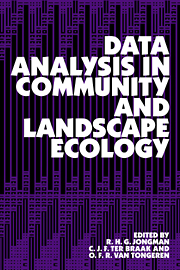Book contents
8 - Numerical methods in practice: case-studies
Published online by Cambridge University Press: 11 October 2009
Summary
Spatial variation in vegetation, soil and precipitation across the Hawkesbury Sandstone Plateau in New South Wales, Australia: an analysis using ordination and trend surfaces
P. A. Burrough
Data collection and analysis
The Hawkesbury Sandstone Plateau, New South Wales, Australia, is an area of great scenic beauty. Through its poor, infertile soils, the plateau has been little developed for agriculture and much of it remains under natural vegetation. This case study was carried out on a small part of the Hawkesbury Sandstone Plateau, measuring roughly 25 km × 10 km from Barren Grounds Nature Reserve in the east, to Fitzroy Falls in the west (Figure 8.1). The eastern boundary of the study area is a steep cliff, where the plateau ends, some 5 km inland from the Tasman Sea. This topography is the cause of intense orographic rainfall, which varies from about 2500 mm per year in the east, falling off to about 1500 mm in the west. Although the plateau is deeply dissected by ravines, its surface is gently rolling, with an average altitude of about 600 m, which does not vary within the area studied. The vegetation, which at the time of the study was largely undisturbed, varies considerably over the area, being a low heath in the east and a closed forest in the west. There is a parallel variation in the soil, from peaty podzols in the east, through leached podzols to leached brown soils in the west.
- Type
- Chapter
- Information
- Data Analysis in Community and Landscape Ecology , pp. 252 - 274Publisher: Cambridge University PressPrint publication year: 1995



